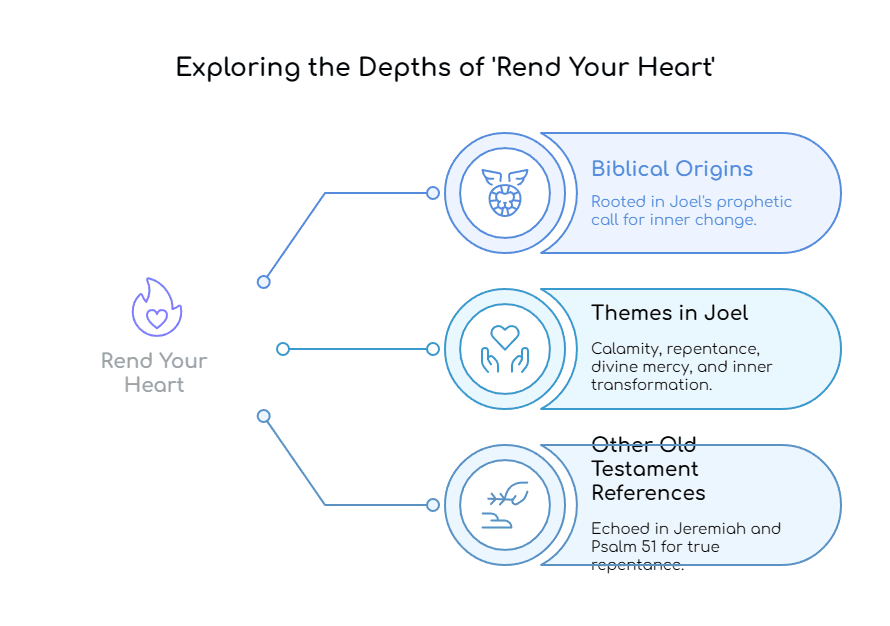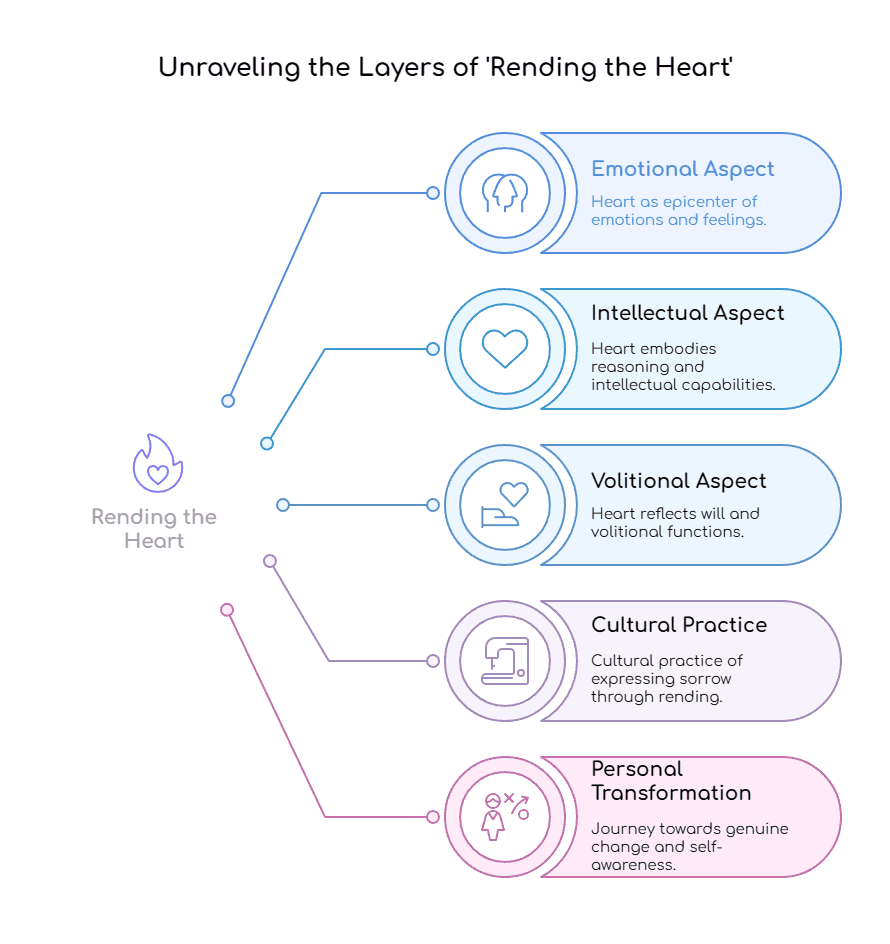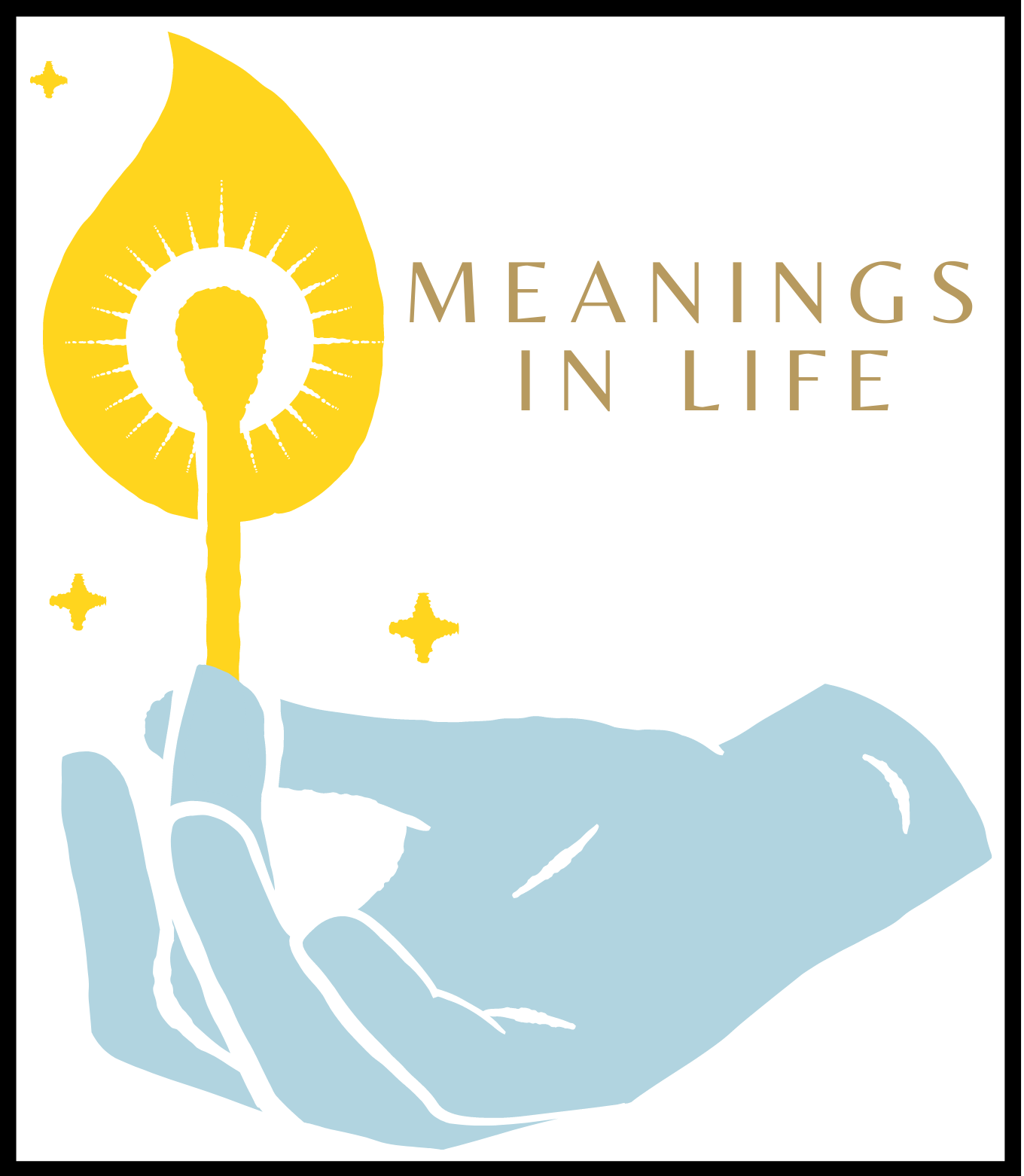In our quest for understanding, let’s first dissect the phrase ‘rend your heart’. To rend is to tear something into two or more pieces – a violent act that signifies deep emotion.
When combined with ‘your heart’, it conjures vivid imagery of dramatic internal struggle. However, we are not talking about a literal tearing of one’s physical organ here; this is a metaphorical discourse.
The sentiment expressed concerns an intense emotional and spiritual transformation – an earnest plea for inner change so profound, it’s likened to tearing one’s own heart. But why would anyone want to inflict such damage upon themselves?
It might seem counterintuitive initially. Still, by peeling back layers of biblical context and symbolism, we may uncover the profound wisdom hidden within this ancient directive.
Back to Basics: The Biblical Context of ‘Rending One’s Heart’
If you’re conversant with biblical texts, you’ll recognize that phrases like these aren’t unusual. The Bible brims with allusions like these – rich in symbolism and metaphor – that call for introspection and encourage spiritual growth. The injunction to “rend your heart” is from the Old Testament Book of Joel. Herein lies its first mention in the Bible where it was used as a plea for genuine repentance and change of heart among God’s people.
Joel 2:13 reads “So rend your heart, and not your garments; return unto the LORD your God…” Thus, in its original context, ‘rend your heart’ was not just about feeling sadness over wrongdoing but about demonstrating true remorse leading to significant inner change — a transformative repentance manifesting in behaviors consistent with God’s teachings.
This unveiling offers us insight into why this seemingly violent phrase was used – it wasn’t to advocate suffering, but to invite sincere and meaningful self-examination. The Bible invites us to ‘rend our hearts’, to tear away the barriers we’ve erected against genuine transformation and spiritual growth.
That’s a message that resonates across ages, transcending religious boundaries. As we delve deeper into this subject, we’ll unfold more layers of meaning and relevance of this potent biblical statement.
The Old Testament: Where It All Began

Exploring the Origins: The Book of Joel
The phrase ‘rend your heart’ traces its roots back to the Old Testament, specifically within the confines of a minor prophet’s utterances – Joel. This book, albeit brief, is potent with rich metaphors and vivid imagery swirling around themes of calamity, repentance, and divine mercy. The call to rend one’s heart emanates from this prophetic milieu.
In truth, the Book of Joel paints a remarkable canvas depicting God’s relationship with His people. It explores how adversity can be both chastisement for disobedience and an invitation to return to God—a return initiated through a sincere self-mortification or ‘rending’ of one’s heart.
This symbolic act is not merely about the physicality but rather focuses on internal transformation. When we dive deeper into these ancient words penned by Joel, we uncover layers of profound wisdom that still resonate in today’s world.
‘Rend Your Heart’: Unpacking Joel 2:13
Joel 2:13 serves as our primary reference point when examining this biblical phrase. Herein lies the commandment: “And rend your heart and not your garments”. The verse continues with a description that offers insight into God’s gracious nature—He is slow to anger, full of kindness, and relenting from doing harm.
The phrase ‘rend your heart’ was addressed initially to Israel as they faced a cataclysmic locust plague symbolizing divine judgement. Literally tearing one’s clothes or ‘rending’ was an established expression of grief or repentance in Hebrew tradition—but Joel emphasizes that God desires more than just outward shows of penitence; what He truly yearns for is inner transformation.
By urging people to ‘rend their hearts’, Joel essentially calls for a sincere, heartfelt repentance that goes beyond superficial acts. It is a plea for individuals to allow their innermost beings—their hearts—to be pierced by the awareness of their failings, leading them to genuine remorse and change.
Other Old Testament References and Their Implications
The theme of rending one’s heart permeates other sections of the Old Testament as well. For instance, in the Book of Jeremiah, God expresses His desire for His people’s circumcised hearts.
This metaphorical circumcision, akin to rending one’s heart, signifies an internal purging of impurities and sinful inclinations. Another noteworthy reference can be found in Psalm 51.
Here King David, contrite after his sins were laid bare before him, pleads with God for a clean heart and a steadfast spirit. This exemplifies how acknowledging one’s sinfulness—and facing it head-on-is the first step towards true repentance and interior renewal.
These cross-references underline that rending one’s heart is not an isolated concept within biblical literature but forms part of a broader narrative emphasizing sincere repentance and transformation from within. It suggests that external practices are meaningless unless accompanied by profound internal changes—an intriguing insight remaining relevant even today.
Understanding the Metaphor: It’s More than Just Tearing Cloth

Demystifying Ancient Symbolism: A Tapestry Unraveled
To comprehend the profound metaphorical significance of ‘rending one’s heart,’ we must journey back to biblical times. Rending, or tearing, was a customary action during periods of intense grief or repentance.
When struck by calamity, individuals in ancient Israel would tear their garments as an outward expression of their inner turmoil. This act was not merely dramatic theatrics; it was a deeply ingrained cultural practice that demonstrated sincere sorrow and contrition.
But why tear one’s clothing? In the ancient world, clothing was an essential part of personal identity – it denoted social status, profession, and could even reflect emotional states.
Therefore, purposely damaging one’s attire indicated a willingness to disrupt one’s identity significantly; it symbolized a deep-seated desire for change. Yet, when Joel asks for hearts to be rent instead of garments (Joel 2:13), he is calling for more than just symbolic gestures; he implores his audience to experience genuine change from within – a transformation that goes beyond superficial expressions of sorrow.
The Heart-Beat of Biblical Terminology: When Emotion Meets Metaphor
The term ‘heart’ in the Bible is often associated with our modern understanding – primarily as the epicenter of emotion and feeling. However, it holds a much broader connotation in biblical literature where it represents not only emotions but also intellect and will.
In Hebrew thought and language (which forms much of Old Testament scripture), the heart (‘lev’ in Hebrew) is considered as harboring elements far beyond sentimentality. It encapsulates reasoning capabilities (‘understanding heart’), volitional functions (‘willing heart’), moral conscience (‘clean heart’), courage (‘take heart’), memory (‘know by heart’), and even represents the entire inner being of a person.
So, when Joel refers to ‘rending one’s heart,’ he invites us to a comprehensive transformation that includes our feelings, thoughts, and decisions. It is an appeal for an inward metamorphosis that affects all aspects of our personal life and character.
Unveiling the Heart of the Matter: More Than Just a Muscle
In essence, ‘rending one’s heart,’ signifies breaking open the deepest parts of ourselves – it means laying bare our beliefs, desires, aspirations, failings, and fears – in an act of ultimate vulnerability. It’s about stripping away layers of defense and pretense until what remains is raw and real.
This call for heartfelt authenticity extends beyond just religious interpretation; it resonates with any introspective journey towards self-awareness. It requires us to confront uncomfortable truths about ourselves – to accept them, change them where necessary – thus enabling us to grow as individuals.
Therefore, this potent metaphor serves not only as a spiritual exhortation but also as practical wisdom for personal development. It underlines the importance of introspection in leading lives that are not only outwardly prosperous but inwardly fulfilled.
Rending vs Repenting: A Crucial Distinction

Stepping into the Arena of Biblical Semantics: Rending vs Repenting
While both ‘rend your heart’ and ‘repentance’ involve rich biblical symbolism, they are not synonymous terms. The original Hebrew word for repentance, ‘teshuvah’, connotes returning to a state of righteousness or turning away from sin.
On the other hand, the term to ‘rend your heart’ (from the Hebrew ‘kara lev’) implies an intense emotional response that catalyzes this turn towards righteousness. The act of repentance is often seen as something that we decide to do – a conscious choice spurred by recognition of our errors.
We are moved by guilt or conviction and resolve to change our ways. Here, the focus is on willpower; it’s about making a deliberate decision and sticking with it.
In contrast, rending one’s heart is an involuntary reaction – a profound emotional upheaval that shakes us to our core. It isn’t about cold resolution – it’s visceral, raw and deeply personal.
Unraveling Misconceptions: Why ‘Rending One’s Heart’ Goes Beyond Apologies
There could be a tendency amongst some readers to perceive ‘rending your heart’ as merely feeling sorry for one’s sins or expressing contrition. However, such interpretation barely scratches the surface of this biblical concept.
When we feel sorry for something we’ve done wrong, there’s often an element of self-pity involved – we regret being caught or facing consequences rather than genuinely lamenting our actions. This isn’t what rending one’s heart signifies in biblical terms.
‘Rend your heart’ doesn’t simply advocate for remorse; instead, it calls for radical interior transformation–a wholehearted commitment to shift away from behaviors and attitudes that lead us astray. It encourages vulnerability before God, an open admission of our weaknesses and the poignant acknowledgment that we cannot change without divine assistance.
The Power of Emotional Vulnerability: Rending as a Doorway to Genuine Transformation
Simply feeling sorry keeps us stuck in a cycle of sin and regret. We wallow in guilt, pledge to change, but often go back to our old habits after a while.
This is where rending one’s heart achieves what mere remorse fails to – it encourages genuine self-examination and fosters authentic transformation. Rending one’s heart strips away the veneer of self-deception that can accompany mere remorse.
It compels us to face the hard truths about ourselves that we’ve been avoiding or denying, perhaps even for years. When we rend our hearts, we expose our deepest sins and flaws not just to ourselves but also before God.
In this state of total vulnerability, there’s no room for half-hearted repentance or superficial apologies. Instead, there is space only for earnest contrition and sincere commitment to personal transformation—a commitment anchored not in fleeting emotion but in enduring faith.
Rending One’s Heart in Modern Christianity
The Modern Christian Interpretation: A Call to Genuine Change
In today’s Christian milieu, the term ‘rend your heart’ still holds an evocative power and is perceived as a profound invitation to heart-centered transformation. It is interpreted as a call to break open one’s innermost being, tearing down walls of selfishness, pride, and superficiality that hinder a deep relationship with God.
This isn’t merely an emotional catharsis; instead, it urges Christians to sincerely reassess their priorities and behaviors. Continually throughout modern Christianity, ‘rend your heart’ has been embraced as an exhortation to humble oneself before God genuinely.
Unlike the public displays of spirituality often seen today in social media posts or televised worship services, rending one’s heart suggests a more private and personal spiritual journey. It invites believers into authentic self-examination followed by heartfelt repentance.
The term offers Christians a metaphorical language for describing significant moments of spiritual change or enlightenment. It brings images not only of pain but also of healing – much like how a surgeon must first make an incision in order to treat what lies beneath the surface.
Case Studies: Examples from Contemporary Pulpits and Pages
‘Rend your heart’ continues to echo through modern sermons, teachings, and writings. For example, renowned evangelist Billy Graham used this phrase in numerous sermons throughout his career, stressing that external forms of piety were insufficient without genuine repentance symbolized by ‘rending one’s heart.’
In her book “Broken Way,” popular Christian author Ann Voskamp explores themes related to rending one’s heart. Through personal stories about her own experiences with suffering and loss, she invites her readers into deeper authenticity with God and others – living out Joel 2:13.
Similarly consider Rick Warren, pastor and best-selling author of “The Purpose Driven Life,” who emphasizes ‘rending one’s heart’ when discussing the importance of sincere repentance in his teachings. He often encourages his congregation and readers to look inward, identify their sins, and make a conscious effort to ‘rend their hearts,’ fostering true change within themselves.
Concluding these cases, it is clear that the invitation to ‘rend your heart’ continues to resonate within Christianity today. It serves as a reminder of an ancient truth — real transformation originates not from external displays but from deep within the core of our very being.
‘Rend Your Heart’: Its Relevance Beyond Religion
A Psychological Perspective on ‘Rending’
Even when explored outside the realm of biblical theology, the phrase ‘rend your heart’ offers a profound message. Seen through the lens of psychology, this idiom captures a process of deep introspection and emotional transformation.
To rend is to tear apart, to split violently. In psychological terms, this might be viewed as a call to dissect our emotional selves, to delve deeply within our psyches and scrutinize our behaviors, motivations, feelings, and thoughts.
This self-examination can lead to greater self-awareness and insight into our mental processes. This interpretive approach highlights the relevance of ‘rending’ for mental health.
In therapy or counseling—whether cognitive-behavioral or psychodynamic—clients are often encouraged to confront their deepest fears and darkest emotions. This figurative rending can lead to catharsis—a release of repressed emotions—and pave the way for healing and growth.
Universal Lessons from an Ancient Phrase
The concept of ‘rending your heart,’ stripped from its religious context, still radiates universal appeal. It speaks volumes about self-reflection-a process not exclusive to any belief system but integral part of human experience.
For those who don’t subscribe to religious doctrines yet yearn for personal growth or change—the symbolism inherent in ‘rend your heart’ offers valuable lessons. It underscores that genuine change comes from an authentic examination of one’s innermost feelings—not superficial adjustments but a deep-rooted transformation emanating from one’s core.
Moreover, it serves as a poignant reminder that sometimes it takes courageously ripping open old wounds—an inner turmoil—to catalyze authentic change. Like peeling back layers of an onion—the tears might sting—but once you reach the heart of it all—you gain clarity about who you are at your core.
So, irrespective of religious belief or absence thereof, ‘rend your heart’ is a masterful metaphor for the transformative power of introspection. Whether we are believers on a spiritual journey or simply humans trying to better ourselves, the phrase provides an evocative image for profound self-examination leading to real change.
Conclusion: The Enduring Power of an Ancient Phrase
A Proverb of Timeless Resonance: Why ‘Rend your Heart’ Still Echoes Today
In our contemporary era, one might wonder why a phrase so archaic as ‘rend your heart’ retains its poignancy. It is inherently tied to the human condition – our propensity for self-reflection and potential for transformation. The phrase cuts through the superficialities that often consume our everyday lives, reminding us of the profound depth and complexity within each individual.
The idea of tearing open one’s heart speaks to our innate yearning for authenticity and raw emotionality. Yet, it’s not just about emotional openness or vulnerability; it’s about striving towards a higher level of personal growth and spiritual maturity.
To rend your heart is to face your innermost fears, insecurities, and wrongdoings head-on. It requires bravery to tear away the hardened layers built around our hearts due to hurt or disillusionment.
The concept also applies on a broader societal level. In a world plagued by conflict, division, and misunderstanding, ‘rending our hearts’ could be interpreted as opening ourselves up more wholly to those different from us—increasing understanding, empathy, and ultimately unity.
The Lasting Call for Self-Examination: Potentiality in Transformation
In every era of human history – from biblical times till today – we see individuals who heed this call for self-examination instigating waves of change in their societies. From figures like Mahatma Gandhi echoing “Be the change you wish to see in world” to modern-day advocates like Malala Yousafzai championing education as a transformative tool against extremism—their actions resonate with the essence of ‘rending one’s heart.’ Delving into self-examination is no mere navel-gazing exercise; it propels us toward actionable change.
When we rend our hearts, we incite a thought revolution that moves us from passive acceptance of our flaws to active rectification. It’s an internal transformation with far-reaching external implications.
And while it may seem daunting to begin this introspective journey, remember that the process is gradual and the benefits, profound. As you grapple with your inner demons and learn to let go of what no longer serves you, you become more resilient and compassionate—giving rise to a ripple effect on those around you.
In Closing: The Transformative Power of Rending Your Heart
The phrase ‘rend your heart’ carries an enduring significance because of its profound call towards self-examination and subsequent transformation. Though ancient in its origins, its resonance persists today as it continues to offer valuable insights for personal growth and societal development. This journey is not for the faint-hearted-it demands courage to face one’s imperfections and vulnerabilities; it requires resilience to weather through uncomfortable truths about oneself.
However, in accepting this challenge lies immense potential for personal evolution—one that incites positive change on a larger scale. So here’s an optimistic spin on this introspective journey: Rend your heart and unveil the beauty lying beneath layers of doubt or fear—you may just discover a wellspring of strength you never knew existed within you.




